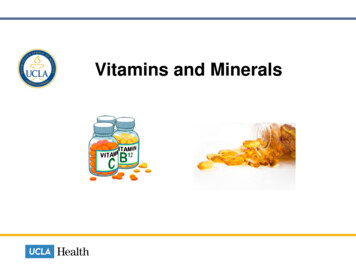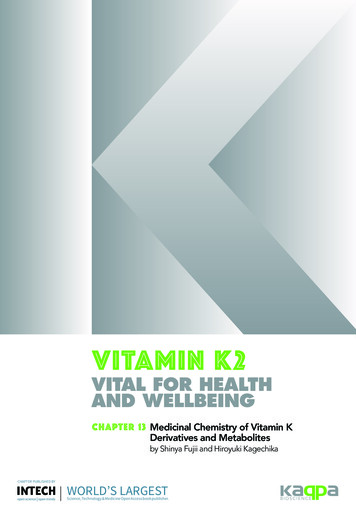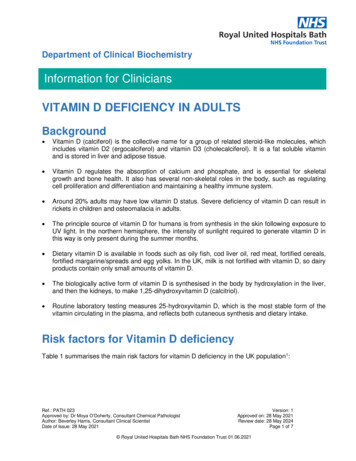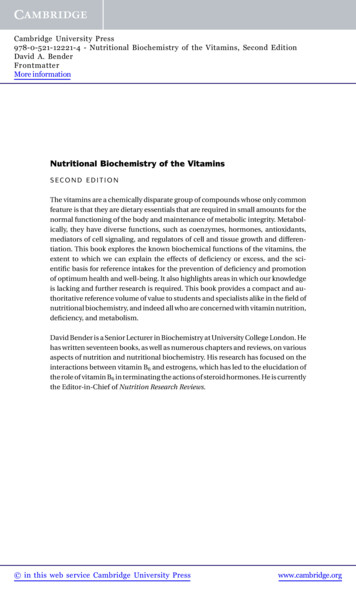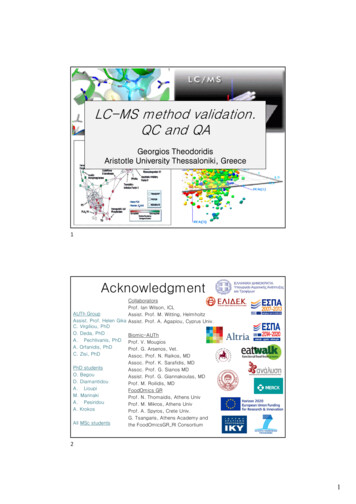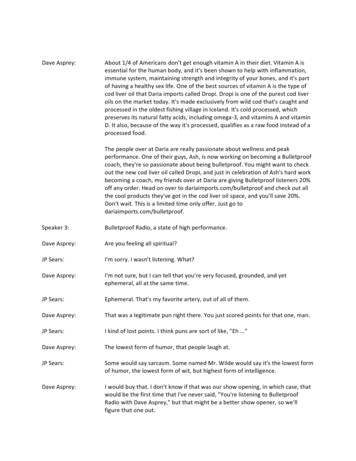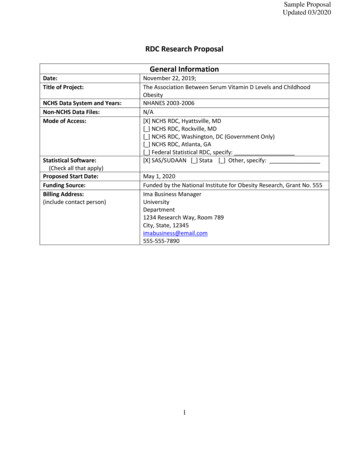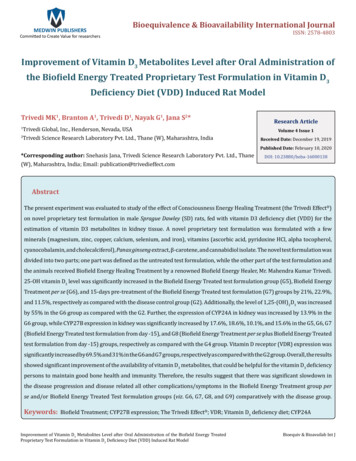
Transcription
MEDWIN PUBLISHERSBioequivalence & Bioavailability International JournalISSN: 2578-4803Committed to Create Value for researchersImprovement of Vitamin D3 Metabolites Level after Oral Administration ofthe Biofield Energy Treated Proprietary Test Formulation in Vitamin D3Deficiency Diet (VDD) Induced Rat ModelTrivedi MK1, Branton A1, Trivedi D1, Nayak G1, Jana S2*Trivedi Global, Inc., Henderson, Nevada, USATrivedi Science Research Laboratory Pvt. Ltd., Thane (W), Maharashtra, India12*Corresponding author: Snehasis Jana, Trivedi Science Research Laboratory Pvt. Ltd., Thane(W), Maharashtra, India; Email: publication@trivedieffect.comResearch ArticleVolume 4 Issue 1Received Date: December 19, 2019Published Date: February 10, 2020DOI: 10.23880/beba-16000138AbstractThe present experiment was evaluated to study of the effect of Consciousness Energy Healing Treatment (the Trivedi Effect )on novel proprietary test formulation in male Sprague Dawley (SD) rats, fed with vitamin D3 deficiency diet (VDD) for theestimation of vitamin D3 metabolites in kidney tissue. A novel proprietary test formulation was formulated with a fewminerals (magnesium, zinc, copper, calcium, selenium, and iron), vitamins (ascorbic acid, pyridoxine HCl, alpha tocopherol,cyanocobalamin, and cholecalciferol), Panax ginseng extract, β-carotene, and cannabidiol isolate. The novel test formulation wasdivided into two parts; one part was defined as the untreated test formulation, while the other part of the test formulation andthe animals received Biofield Energy Healing Treatment by a renowned Biofield Energy Healer, Mr. Mahendra Kumar Trivedi.25-OH vitamin D3 level was significantly increased in the Biofield Energy Treated test formulation group (G5), Biofield EnergyTreatment per se (G6), and 15-days pre-treatment of the Biofield Energy Treated test formulation (G7) groups by 21%, 22.9%,and 11.5%, respectively as compared with the disease control group (G2). Additionally, the level of 1,25-(OH)2D3 was increasedby 55% in the G6 group as compared with the G2. Further, the expression of CYP24A in kidney was increased by 13.9% in theG6 group, while CYP27B expression in kidney was significantly increased by 17.6%, 18.6%, 10.1%, and 15.6% in the G5, G6, G7(Biofield Energy Treated test formulation from day -15), and G8 (Biofield Energy Treatment per se plus Biofield Energy Treatedtest formulation from day -15) groups, respectively as compared with the G4 group. Vitamin D receptor (VDR) expression wassignificantly increased by 69.5% and 31% in the G6 and G7 groups, respectively as compared with the G2 group. Overall, the resultsshowed significant improvement of the availability of vitamin D3 metabolites, that could be helpful for the vitamin D3 deficiencypersons to maintain good bone health and immunity. Therefore, the results suggest that there was significant slowdown inthe disease progression and disease related all other complications/symptoms in the Biofield Energy Treatment group perse and/or Biofield Energy Treated Test formulation groups (viz. G6, G7, G8, and G9) comparatively with the disease group.Keywords: Biofield Treatment; CYP27B expression; The Trivedi Effect ; VDR; Vitamin D3 deficiency diet; CYP24AImprovement of Vitamin D3 Metabolites Level after Oral Administration of the Biofield Energy TreatedProprietary Test Formulation in Vitamin D3 Deficiency Diet (VDD) Induced Rat ModelBioequiv & Bioavailab Int J
Bioequivalence & Bioavailability International Journal2IntroductionDuring the Industrial Revolution, the majority ofpopulation started moving from the farms to the cities andthis is the time when rickets became a public health problem.Therefore, the use of various foods such as cod liver oil as wellas plants were started widely that were found to be helpful inthe prevention or cure of this disease, and further leads to thediscovery of vitamin D, i.e., the active ingredient present inthese sources [1]. Vitamin D generally available in two forms(D2 and D3) based on the chemical difference in their sidechains. Vitamin D3, which is also called as cholecalciferol,is synthesized in the skin by ultraviolet irradiation from7-dehydrocholesterol; or it could be taken through diet fromfish oils and fortified dairy products [2-4]. The metabolismof vitamin D inside the body is performed by cytochromeP450 mixed-function oxidases (CYPs), which involve threemain steps, i.e., 25-hydroxylation, 1α-hydroxylation, and24-hydroxylation [5-6]. These CYP enzymes could be found inthe endoplasmic reticulum (CYP2R1) or in the mitochondria(CYP27A1, CYP27B1, and CYP24A1). Vitamin D plays majorrole in the bone formation; however it is observed to be activethroughout the human body, which also affects the responsesof the immune system responses and cell defences [7,8].25-Hydroxyvitamin D (25-OH-D) is considered asthe major circulating form of vitamin D that also acts asthe precursor of the bioactive form of vitamin D i.e., 1,25-dihydroxyvitamin D. The 25-OH Vitamin D is widelyknown for its role in the maintenance of mineral balanceas well as skeletal integrity in the human body [9]. Thelevel of 25OHD is measured in the body that are useful fordetermining the status of vitamin D due to its long half-life.1, 25-Dihydroxy vitamin D is another metabolite of vitaminD that is also known as calcitriol, and is most potent amongall metabolites of vitamin D [10]. The production of calcitriolis regulated by the serum concentrations of calcium,phosphorus, and parathyroid hormone and, it acts in thebody by stimulating the calcium absorption in the intestine[11-14]. Various research studies reported the use of 1,25levels in the blood as an indication for kidney functiondisturbances; chronic kidney failure; haemodialysis; renalosteopathy; metabolism disturbances; osteomalacia fromvarious types of vitamin D; idiopathic hypercalciuria;monitoring of therapy with active vitamin D metabolites; andHypercalcaemia, etc [15-17]. Thus, with this respect in orderto study the vitamin D metabolites in kidney tissues, a noveltest formulation was designed for the estimation of variousbrain biomarkers. The test formulation was combinationof different minerals (selenium, zinc, iron, calcium, copper,and magnesium), vitamins (cyanocobalamin, ascorbic acid,pyridoxine HCl, alpha tocopherol, and cholecalciferol), betacarotene, cannabidiol isolate, and Panax ginseng extract.All the minerals and vitamins used in the test formulationhave significant functional role to provide vital physiologicalrole [18-20]. Besides, biological importance of cannabidiolhas been widely reported [21,22], while ginseng extract isregarded as the one of the best immune booster for overallhealth and immunity [23].The test formulation and the animals per se weretreated with Biofield Energy Healing Treatment and thetest formulation by a renowned Biofield Energy Healer andwas evaluated for its vitamin D metabolites in male SpragueDawley rats kidney tissue. Biofield Energy healing approachcan be used against many disorders and it was acceptedworldwide by more than 80% of the population as one of theComplementary and Alternative Medicine (CAM) treatment[24-26]. National Center for Complementary/AlternativeMedicine (NCCAM) recommended Alternative therapies dueto its more advantages as compared with the current preferredtreatment approach [27]. National Center of Complementaryand Integrative Health (NCCIH) has recognized and acceptedBiofield Energy Healing as a CAM health care approachin addition to other therapies, medicines and practicessuch as deep breathing, natural products, Tai Chi, yoga,therapeutic touch, Qi Gong, Johrei, Reiki, polarity therapy,pranic healing, chiropractic/osteopathic manipulation,meditation, massage, homeopathy, progressive relaxation,special diets, relaxation techniques, movement therapy,mindfulness, Ayurvedic medicine, traditional Chinese herbsand medicines in biological systems [28,29]. The TrivediEffect -Consciousness Energy Healing have been acceptedworldwide, which has been scientifically studies on variousmodels in the metal science [30,31], agriculture science [32],microbiology [33,34], biotechnology [35], and improvedbioavailability of various compounds [36,37], skin health[38,39], dietary supplement [40], cancer research [41],bone health [42,43], overall human health and wellness.The present study was designed to evaluate the vitamin Dmetabolites in kidney tissue of male Sprague-Dawley rats inpresence of VDD diet, which was treated with Biofield EnergyTreatment by a renowned Biofield Energy Healer.Materials and MethodsChemicals and ReagentsPyridoxine hydrochloride (vitamin B6), calcitriol, zincchloride, magnesium (II) gluconate, and β-carotene (Retinol,Provit A) were purchased from TCI, Japan. Copper chloride,cyanocobalamin (vitamin B12), calcium chloride, vitamin E(Alpha-Tocopherol), cholecalciferol (vitamin D3), iron (II)sulfate, and sodium carboxymethyl cellulose (Na-CMC) wereprocured from Sigma-Aldrich, USA. Ascorbic acid (vitaminC) and sodium selenate were obtained from Alfa Aesar,India. Cannabidiol isolate and Panax ginseng extract wereobtained from Panacea Phytoextracts, India and StandardTrivedi MK, et al. Improvement of Vitamin D3 Metabolites Level after Oral Administrationof the Biofield Energy Treated Proprietary Test Formulation in Vitamin D3 Deficiency Diet(VDD) Induced Rat Model. Bioequiv & Bioavailab Int J 2020, 4(1): 000138.Copyright Trivedi MK, et al.
Bioequivalence & Bioavailability International Journal3Hemp Company, USA, respectively. For the estimation ofthyroid biomarkers, specific ELISA kits were used suchas for detection such as TSH and thyroxine was estimatedusing CUSABIO, USA, while parathyroid and calcitonin wasestimated using Clond-Clone, USA.Maintenance of AnimalRandomly breed male Sprague Dawley (SD) rats withbody weight ranges from 200 to 300 gm were used in thisstudy. The animals were purchased from M/s. Vivo BioTech, Hyderabad, India. Animals were randomly dividedinto nine groups based on their body weights consist of6 animals of each group. They were kept individually insterilized polypropylene cages with stainless steel top grillhaving provision for holding pellet feed and drinking waterbottle fitted with stainless steel sipper tube. The animalswere maintained as per standard protocol throughout theexperiment.Consciousness Energy Healing StrategiesThe novel test formulation was consisted of zinc chloride,iron (II) sulfate, copper chloride, vitamin B6, vitamin B12,vitamin D3, sodium selenate, calcium chloride, ascorbicacid, vitamin E, beta carotene, Panax ginseng extract,cannabidiol and magnesium (II) gluconate. Each ingredientof the novel test formulation was divided into two parts.The test formulation was divided into two parts, one part ofthe test compound was not received any sort of treatmentand were defined as the untreated or control sample. Thesecond part of the test formulation was treated with theTrivedi Effect -Energy of Consciousness Healing Treatment(Biofield Energy Treatment) by a renowned Biofield EnergyHealer, Mr. Mahendra Kumar Trivedi under laboratoryconditions for 3 minutes. Besides, three group of animalsalso received Biofield Energy Healing Treatment (known asthe Trivedi Effect ) by Mr. Mahendra Kumar Trivedi undersimilar laboratory conditions for 3 minutes. The test itemswere kept in the research laboratory of Dabur ResearchFoundation, New Delhi, India. The energy transmission wasdone without touching the samples or animals. After that,the Biofield Energy Treated samples was kept in the similarsealed condition and used as per the study plan. In the samemanner, the control test formulation group was subjectedto “sham” healer for 3 minutes energy treatment, underthe same laboratory conditions. The “sham” healer did nothave any knowledge about the Biofield Energy Treatment.The Biofield Energy Treated animals were also taken back toexperimental room for further proceedings.Experimental randomized and grouped based on body weight. The testformulation was prepared freshly prior to dosing andadministered to the animals using an oral intubation needleattached to an appropriately graduated disposable syringe.The dose volume was 10 mL/kg in the morning and eveningbased on body weight. The experimental groups were dividedas G1 as normal control; G2 as disease control (VDD: VitaminD3 Deficient Diet and 0.5% CMC); G3 as reference item (VDDalong with calcitriol at a dose of 1 µg/kg body); G4 includesVDD along with untreated test formulation; G5 as VDD alongwith Biofield Energy Treated test formulation); G6 groupincludes VDD along with Biofield Energy Treatment perse to animals from day -15; G7 as VDD along with BiofieldEnergy Treated test formulation from day -15; G8 groupincludes VDD along with Biofield Energy Treatment perse plus Biofield Energy Treated test formulation from day-15, and G9 group denoted VDD along with Biofield EnergyTreatment per se animals plus untreated test formulation. G1and G2 animals were treated orally with 0.5% w/v CMC-Nain distilled water for 8 weeks (From day 1 to 56). Group G3animal was treated orally with reference item, imipraminehydrochloride at a dose of 30 mg/kg body weight for 8weeks. The freshly prepared suspensions of untreated testformulation and Biofield Energy Treated Proprietary Productwas administered orally to the G4 and G5 group animals,respectively, at a dose of 1257.80 mg/kg body weight in themorning and 2012.75 mg/kg body weight in the evening,respectively for 8 weeks. G6 group was not to be dosed withthe test formulation. In addition; G7 and G8 groups weresimilar to the G4 and G5 dosing regimen, but from the dayof Biofield Energy Treatment (i.e. from day-15 to day 56).G9 group, Biofield Energy Treated animal was treated withuntreated test formulation for 8 weeks. Body weight andclinical signs were taken daily throughout the experimentalperiod. All the animals except G1 group received vitamin D3deficient diet procedures after scheduled dosing daily at aspecified interval to the end of the experiment for 8 weeks.After 8th week of the experimental period, all the animalswere individually subjected to blood collection for theexperimental purpose. Kidney and all other vital organs werecollected and weighed and stored in -80 C for estimation ofvarious biomarkers by ELISA method.EstimationAnalysisofKidneyVitaminD3 MetabolitesKidney homogenate was used from all the animalsfor vitamin D3 metabolites biomarker estimation such as25(OH)D3, 1-25 (OH)2D3, and mRNA expression of CYP24Aand CYP27B along with estimation of vitamin D receptor(VDR) level. All the samples were subjected for the vitaminD3 metabolites biomarker estimation using ELISA method asper manufacturer’s recommended standard procedure. Thiswas a quantitative method and the principle was based onTrivedi MK, et al. Improvement of Vitamin D3 Metabolites Level after Oral Administrationof the Biofield Energy Treated Proprietary Test Formulation in Vitamin D3 Deficiency Diet(VDD) Induced Rat Model. Bioequiv & Bioavailab Int J 2020, 4(1): 000138.Copyright Trivedi MK, et al.
Bioequivalence & Bioavailability International Journal4the quantitative estimation method.Statistical AnalysisThe data were represented as mean standard errorof mean (SEM) and subjected to statistical analysis usingSigma-Plot statistical software (Version 11.0). For multiplecomparison One-way analysis of variance (ANOVA) followedby post-hoc analysis by Dunnett’s test and for between twogroups comparison Student’s t-test was performed. Thep 0.05 was considered as statistically significant.Results and DiscussionThe Effect of the Test Formulation on Kidney 25Hydroxy Vitamin D3Vitamin D deficiency is related with high mortalityin most of the vitamin D deficient population, which isrequired for calcium and phosphate metabolism and bonehomeostasis [44,45]. The results of the test formulation onkidney 25-Hydroxy vitamin D3 are presented in Figure 1. 25OH vitamin D3 was measured in kidney, while its deficiencyis defined as less than 20 ng/mL in body. 25-OH Vitamin D3level in the kidney of rats fed with vitamin D3 deficient diet(G2) was 2786.17 193.73 µg/L, which was significantlydecreased by 11.9% as compared to the normal control(G1, 3145.92 296.94 µg/L). However, positive control(calcitriol) treatment (G3), showed significant increasedlevel (3517.50 193.81 µg/L) by 26.2% as compared tothe G2. The experimental test group, the untreated testformulation to the untreated rats (G4) showed significantincreased 25-OH vitamin D3 level (13165.92 168.28 µg/L)by 10.8% as compared to G2 group. The Biofield EnergyTreated test formulation given to the untreated animals (G5)showed significant increased the kidney 25-OH vitamin D3level (3452.00 343.9 µg/L) by 21% and 9% as comparedto the G2 and G4 groups, respectively. Biofield Energy per seto the animals (G6) showed significant increased the level of25-OH vitamin D3 level (3576.92 292.25 µg/L) by 22.9%and 13% as compared to the G2 and G4 groups, respectively.15-days pre-treatment of the Biofield Energy Treated testformulation (G7) significantly increased the kidney 25-OHvitamin D3 level (3192.08 167.91 µg/L) by 11.5% and1% as compared to the G2 and G4 groups, respectively. Theoverall data suggested that preventive measures taken in theexperimental groups (-15 days) showed better response ascompared with the normal/disease control group. Thus, itcan be assumed that Biofield Energy Treatment per se wouldbe the best alternative preventive approach towards anydiseases/ disorders (Figure 1).Figure 1: The effect of the test formulation on the level of 25-Hydroxy Vitamin D3 in kidney homogenate of Sprague Dawleyrats. G: Group; G1: Normal control (0.5% CMC); G2: Disease control (VDD: Vitamin D3 deficient diet 0.5% CMC); G3: Referenceitem (VDD Calcitriol); G4: (VDD untreated test formulation); G5: (VDD Biofield Energy Treated test formulation); G6:(VDD Biofield Energy Treatment per se to animals from day -15; G7: (VDD Biofield Energy Treated test formulation fromday -15); G8: (VDD Biofield Energy Treatment per se plus Biofield Energy Treated test formulation from day -15), and G9:(VDD Biofield Energy Treatment per se animals plus untreated test formulation). Values are presented as mean SEM (n 6).The Effect of the Test Formulation on Kidney 1,25Dihydroxy Vitamin D31, 25-dihydroxyvitamin D3 is the metabolite of vitamin D,which is one of the most biologically active form, responsiblein bone resorption and intestinal absorption of calcium andphosphorus [46]. The renal formation of 1, 25-(OH)2D3 fromits endogenous precursor, 25-hydroxyvitamin D3 (25-OH Vit.D3) is catalyzed by 25-Hydroxy vitamin-D3-la-hydroxylase (lahydroxylase), an enzyme whose activity can be suppressedTrivedi MK, et al. Improvement of Vitamin D3 Metabolites Level after Oral Administrationof the Biofield Energy Treated Proprietary Test Formulation in Vitamin D3 Deficiency Diet(VDD) Induced Rat Model. Bioequiv & Bioavailab Int J 2020, 4(1): 000138.Copyright Trivedi MK, et al.
5Bioequivalence & Bioavailability International Journalby 1,25-(OH)2D3 and stimulated by parathyroid hormone(PTH) [47]. The experimental data and comparison resultsof the test formulation on kidney 1, 25 Hydroxy vitamin D3are presented in Figure 2. 1, 25 (OH)2 vitamin D3 level inthe kidney with vitamin D3 deficient diet (G2) was 9.59 0.71 ng/mL, which was significantly decreased by 18.5% ascompared to the normal control (G1, 11.77 0.92 ng/mL).Calcitriol (G3) group showed significantly increased thekidney 1,25 (OH)2 vitamin D3 level (10.41 0.31 ng/mL) by8.5% as compared to the G2. G4 group showed significantlydecreased the kidney 1,25 (OH)2 vitamin D3 level (9.72 0.72ng/mL) by 1.2% as compared to the G2. G5 and G6 groupsshowed significant increased kidney 1,25 (OH)2 vitamin D3level by 3.8% and 55%, respectively as compared with the G2.However, G7, G8, and G9 groups showed decreased kidney1,25 (OH)2 vitamin D3 level by 5.1% and 54.2%, respectivelyas compared with the G2 group. The overall data suggestedthat preventive measures taken in the experimental groups(-15 days) showed better response as compared with thenormal groups. Thus, it can be assumed that Biofield EnergyTreatment per se would be the best alternative preventiveapproach towards any bone disorders (Figure 2).Figure 2: The effect of the test formulation on the level of 1, 25-Hydroxy Vitamin D3 in kidney homogenate of Sprague Dawleyrats. G: Group; G1: Normal control (0.5% CMC); G2: Disease control (VDD: Vitamin D3 deficient diet 0.5% CMC); G3: Referenceitem (VDD Calcitriol); G4: (VDD untreated test formulation); G5: (VDD Biofield Energy Treated test formulation); G6:(VDD Biofield Energy Treatment per se to animals from day -15; G7: (VDD Biofield Energy Treated test formulation fromday -15); G8: (VDD Biofield Energy Treatment per se plus Biofield Energy Treated test formulation from day -15), and G9:(VDD Biofield Energy Treatment per se animals plus untreated test formulation). Values are presented as mean SEM (n 6).The Effect of the Test Formulation on kidney mRNAExpression for CYP24ACYP24A is one of the important enzyme that play a vitalrole in calcium homeostasis and the vitamin D endocrinesystem by regulating the level of vitamin D3, as it catalyzesthe conversion of both 25-OH-D3 and 1,25-(OH)2D3 into24-hydroxylated products, which are targeted for excretionusing specialized pathways. CYP24A1 has been clearlyestablished as the key enzyme responsible for vitaminD catabolism [48]. Severe infantile hypercalcemia wasreported due to the abnormal functioning of CYP24A1 [49].The experimental data and comparison results of the testformulation on kidney mRNA expression for CYP24A arepresented in Figure 3. CYP24A expression in the vitaminD3 deficient diet (G2) was 31.14 0.51 AU decreased by0.5% as compared to the normal control (G1). Calcitrioltreatment showed significantly decreased kidney CYP24Aexpression (27.71 0.29AU) by 11% as compared to theG2. G4 group showed significantly decreased the kidneyCYP24A expression (27.71 0.36AU) by 11% as comparedto the G2. G5 group showed reduced level by 3.1%, whileincreased expression of kidney CYP24A expression by 13.9%as compared with the G4. Overall, the data suggested thatthe Biofield Energy Treatment per se significantly improvedthe enzyme expression in kidney in all the experimentalpreventive treatment groups as compared with the normaltreatment approach (Figure 3).Trivedi MK, et al. Improvement of Vitamin D3 Metabolites Level after Oral Administrationof the Biofield Energy Treated Proprietary Test Formulation in Vitamin D3 Deficiency Diet(VDD) Induced Rat Model. Bioequiv & Bioavailab Int J 2020, 4(1): 000138.Copyright Trivedi MK, et al.
6Bioequivalence & Bioavailability International JournalFigure 3: The effect of the test formulation on the level of kidney mRNA Expression for CYP24A in kidney homogenate ofSprague Dawley rats. G: Group; G1: Normal control (0.5% CMC); G2: Disease control (VDD: Vitamin D3 deficient diet 0.5%CMC); G3: Reference item (VDD Calcitriol); G4: (VDD untreated test formulation); G5: (VDD Biofield Energy Treated testformulation); G6: (VDD Biofield Energy Treatment per se to animals from day -15; G7: (VDD Biofield Energy Treated testformulation from day -15); G8: (VDD Biofield Energy Treatment per se plus Biofield Energy Treated test formulation fromday -15), and G9: (VDD Biofield Energy Treatment per se animals plus untreated test formulation). Values are presented asmean SEM (n 6).The Effect of the Test Formulation on kidney mRNAExpression for CYP27BA CYP27B expression in the kidney has found animportant role in calcitonin pathway in the kidney and inextra-renal tissues [50, 51]. Thus, the experimental data wasreported and compared in animal model and is presented inFigure 4. The results suggested that vitamin D3 deficient diet(G2) was found to be 33.29 0.29 AU, which was decreasedby 8.3% as compared to the normal control (G1, 36.29 0.36AU). However, calcitriol treatment (G3) showed significantlydecreased kidney CYP27B expression (28.86 0.55 AU) by13.3% as compared to the G2. G4 group showed significantdecreased the kidney CYP27B expression (28.43 1.51 AU)by 14.6% as compared to the G2. G5 showed increased thekidney CYP27B Expression by 17.6% as compared to G4. G7,G8, and G9 groups showed significant decreased expressionof kidney CYP27B by 6%, 1.3%, and 13.7%, respectivelyas compared with the G2, while G6, G7, and G8 showedincreased expression of CYP27B by 18.6%, 10.1%, and15.6%, respectively, as compared with the G4 (Figure 4).Figure 4: The effect of the test formulation on the level of kidney mRNA Expression for CYP27B in kidney homogenate ofSprague Dawley rats. G: Group; G1: Normal control (0.5% CMC); G2: Disease control (VDD: Vitamin D3 deficient diet 0.5%CMC); G3: Reference item (VDD Calcitriol); G4: (VDD untreated test formulation); G5: (VDD Biofield Energy Treated testformulation); G6: (VDD Biofield Energy Treatment per se to animals from day -15; G7: (VDD Biofield Energy Treated testformulation from day -15); G8: (VDD Biofield Energy Treatment per se plus Biofield Energy Treated test formulation fromday -15), and G9: (VDD Biofield Energy Treatment per se animals plus untreated test formulation). Values are presented asmean SEM (n 6).Trivedi MK, et al. Improvement of Vitamin D3 Metabolites Level after Oral Administrationof the Biofield Energy Treated Proprietary Test Formulation in Vitamin D3 Deficiency Diet(VDD) Induced Rat Model. Bioequiv & Bioavailab Int J 2020, 4(1): 000138.Copyright Trivedi MK, et al.
7Bioequivalence & Bioavailability International JournalThe Effect of the Test Formulation on kidney VDRexpressionThe importance of vitamin D nuclear receptor (VDR)regulates gene expressions that are needed for calciumand phosphate homeostasis, cellular proliferation anddifferentiation, and immune response, largely in a liganddependent manner [53,54]. VDR mediate the biological roleof vitamin D and its expression was reported in most of thetissues such as bone, kidney, thyroid, and intestine, liver,kidney, and adipose tissue along with major organs [55]. VDRlevel in the kidney of rats was studies and is presented inFigure 5. Vitamin D3 deficient diet (G2) group showed level ofVDR 15.66 2.37 ng/mL, which was significantly decreasedby 64.4% as compared to the normal control (G1, 44 9.27ng/mL). Calcitriol treatment (G3), treatment showed anincreased the kidney VDR level (16.50 2.42 ng/mL) by5.4% as compared to the G2. G4, G6, and G7 groups showedan increased the kidney VDR level by 16%, 69.5%, 31%, and8%, respectively as compared with the G2. However, kidneyVDR level was significantly increased by 46.1% and 12.9%in G6 and G7 groups, respectively as compared with the G4group. Overall, the data suggested that the Biofield EnergyTreatment per se significantly improved the VDR expressionin kidney in all the experimental groups along with thepreventive treatment groups (Figure 5).Figure 5: The effect of the test formulation on the level of kidney VDR level in kidney homogenate of Sprague Dawley rats. G:Group; G1: Normal control (0.5% CMC); G2: Disease control (VDD: Vitamin D3 deficient diet 0.5% CMC); G3: Reference item(VDD Calcitriol); G4: (VDD untreated test formulation); G5: (VDD Biofield Energy Treated test formulation); G6: (VDD Biofield Energy Treatment per se to animals from day -15; G7: (VDD Biofield Energy Treated test formulation from day -15);G8: (VDD Biofield Energy Treatment per se plus Biofield Energy Treated test formulation from day -15), and G9: (VDD Biofield Energy Treatment per se animals plus untreated test formulation). Values are presented as mean SEM (n 6).Thus, the present research plan defined four groups,which were considered as preventive maintenance groupsviz. G6, G7, G8, and G9, where the Biofield Energy Treatmentper se and/or Biofield Energy Treated Test formulation incombination was used as preventive maintenance group.The results showed the significant slowdown of the diseaseprogression, disease related all other complications andalso reduced the chances of disease susceptibility in thesegroups. Specifically, group G6 (preventive Biofield EnergyTreatment group per se) showed the best results as aprophylactic/preventive treatment group compared to theother groups. Based on the overall data, it suggests thatthe Biofield Energy Healing Therapy was found to be mosteffective and benefited in order to prevent and protect fromthe occurrence of any type of bone related diseases in ratmodel. It indicated that Biofield Energy Treatment can act asa preventive maintenance therapy to slow down the diseaseprogression and disease related complications of the existingaliments that will ultimately improve the overall health andquality of life in human.ConclusionsThe present animal experimental study revealed thesignificance of Biofield Energy Treated test formulation andBiofield Energy per se on the vitamin D metabolites in kidneytissues. The Biofield Energy Treated test formulation (G5),Biofield Energy Treatment per se (G6), and 15-days pretreatment of the Biofield Energy Treated test formulation(G7) groups were reported with an increased kidney 25-OHvitamin D3 level by 21%, 22.9%, and 11.5%, respectivelyas compared with the disease control group (G2). Further,Trivedi MK, et al. Improvement of Vitamin D3 Metabolites Level after Oral Administrationof the Biofield Energy Treated Proprietary Test Formulation in Vitamin D3 Deficiency Diet(VDD) Induced Rat Model. Bioequiv & Bioavailab Int J 2020, 4(1): 000138.Copyright Trivedi MK, et al.
Bioequivalence & Bioavailability International Journal8G6 group was reported with an increased level of renalformation of 1,25-(OH)2D3 by 55% as compared with theG4. CYP
Deficiency Diet (VDD) Induced Rat Model Bioequiv Bioavailab Int J Improvement of Vitamin D 3 Metabolites Level after Oral Administration of the Biofield Energy Treated Proprietary Test Formulation in Vitamin D 3 Deficiency Diet (VDD) Induced Rat Model Trivedi MK1, Branton A1, Trivedi D1, Nayak G1, Jana S2*

